How ‘A Murder at the End of the World’ Creators’ ‘The OA’ Misfortune Fueled Their New Series
- Oops!Something went wrong.Please try again later.
- Oops!Something went wrong.Please try again later.
- Oops!Something went wrong.Please try again later.

A Murder at the End of the World creators Brit Marling and Zal Batmanglij are a resilient duo. Instead of letting disappointment linger, the longtime creative partners quickly rebounded after the cancellation of their beloved genre-bender The OA and channeled its many profound takeaways into their next story. The Netflix series struck a deep chord in viewers around the world, and seeing firsthand the community and energy that had formed around their work, Marling and Batmanglij further trusted their storytelling instincts until a new name rose to the top of their collective mind: Darby Hart.
Their FX on Hulu limited series chronicles past-and-present Darby (Emma Corrin), who’s an amateur sleuth turned true-crime author. She combines the hacking and investigative skills of Mr. Robot’s Elliot Alderson and Girl with the Dragon Tattoo’s Lisbeth Salander, with the death-adjacent upbringing of Six Feet Under‘s Claire Fisher. Despite those familiar comps, Darby soon becomes her own unique force, as she stops at nothing to solve a murder at an exclusive tech retreat in Iceland, all while attempting to reconcile her relationship with her first love and former partner in true crime, Bill Farrah (Harris Dickinson).
More from The Hollywood Reporter
After portraying the central figure on The OA, Marling opted for a supporting yet integral role as Lee Anderson, a former hacker who’s now the wife of Andy Ronson (Clive Owen), the tech billionaire who’s hosting the remote Icelandic getaway. Marling’s choice not only revolved around her desire to direct three out of the murder-mystery’s seven episodes, but it also stemmed from wanting to create a complex female role for the next generation, an option that wasn’t available to her after she broke out at the 2011 Sundance Film Festival with Sound of My Voice and Another Earth.
“Darby Hart came from a place of wanting to write the kind of role that wasn’t an offer when I was coming of age, and to try to think about the project of telling stories that include new people in them, as a more intergenerational project,” Marling tells The Hollywood Reporter.
Helping create opportunities extends to Batmanglij as well. He and Marling have always served as co-writers, whether it was their two series or their two films, Sound of my Voice and The East (2013), and then he’d focus on directing while she acted. However, on Murder at the End of the World, Batmanglij willingly relinquished his role as “the director,” so that Marling could helm the series premiere and set the tone for the remaining episodes, including the four he directed.
“I knew that Brit was going to be a natural director; I just didn’t understand how much I would enjoy the experience of watching Brit direct,” Batmanglij says. “Certain actors, when they get into the directing chair, just have a sensitivity. I saw Emma and Harris bloom in certain ways when Brit was working with them, and that inspired me to want to go take acting classes.”
Even at a time when the streaming bubble has seemingly burst, Marling and Batmanglij remain optimistic about finishing The OA someday. But the terms would have to be creatively favorable when you consider that they already shot down Netflix’s offer of a wrap-up movie.
“Twin Peaks came back after a long time. We just need the conditions and the circumstances to be right. Dormant seeds in the desert do bloom, so who knows?” Marling says.
Below, during a recent conversation with THR, Marling and Batmanglij also discuss their new series’ dual narrative and how The OA’s subreddit had a hand in inspiring Darby and Bill’s own Reddit-based union.
Well, as soon as I read the announcement about A Murder at the End of the World, the heartbroken OA fan in me immediately grabbed onto the word “limited,” and I said to myself, “Oh, they went limited to avoid the same fate as the last show.” So was the format actually a response to the OA’s premature cancellation?
Brit Marling: I don’t think we had thought of it that way. It might be because we usually don’t decide the length of a story until the story is fully formed, and then it tells you what it wants to be. We have some ideas between us where we’re like, “Oh, that’s like a poem, so it’s just two hours. It’s a film.” And when this idea came to us, it was like, “Oh, this is a clear novel with a beginning, a middle and an end where a young amateur sleuth is invited on a tech retreat. We know the ending, and it only needs about seven-to-eight hours to tell.” So that’s really where the limited format came from, but I’m curious what Zal will say.
Zal Batmanglij: The OA ending was unexpected to me, but they did try to get us to wrap it up with a movie and we said no. So I didn’t feel burnt because of that; I felt more puzzled. If you’re Netflix, why don’t you just finish it with more than just a wrap-up movie? Why don’t you finish it with a third season? It would force us to bring the three [remaining and planned] seasons into one and close it up, and then you could outsource it to Max or Hulu or wherever. You can do so much with it if it’s finished. This idea of all these unfinished homes littering their platform, I just don’t see the economics of it. It’s much better to have a finished thing and then license that thing and make money off that thing for the next 10-to-20 years. So we didn’t feel bitter about it, and when Darby [Emma Corrin] came to us, we just saw, as Brit said, a beginning, middle, and end. But maybe, subconsciously, we were [protecting ourselves]. But everything these days is a limited series in the sense that the season has become the new pilot. Big Little Lies was a limited series, but it’s now an ongoing series. True Detective was a limited series, but it’s ongoing. So it’s smart to do a beginning, middle, and end for any season that you do.
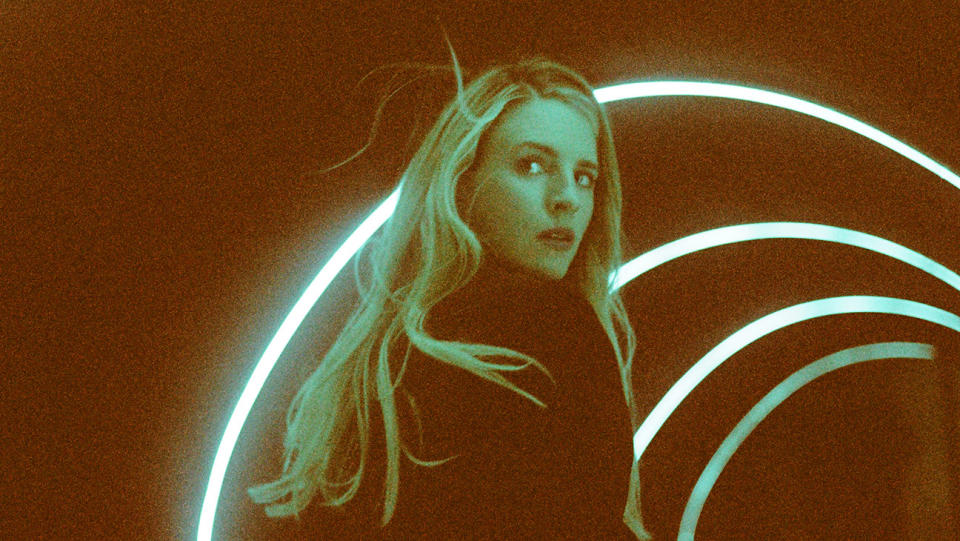
You said that you weren’t bitter about The OA’s cancellation, but did it take a minute for the two of you to pick yourselves back up again? Or were you back at it Monday morning?
Batmanglij: We were back at it Monday morning. We just love to talk about ideas with each other, but we usually don’t talk about them when we’re working on something. We put every ounce we have into making something, and the moment we’re not making something, we get to talk ideas. And Darby was one of the many ideas that we were talking about in 2019, and then she just rose to the top of the pack.
Marling: That might also be because the fan response to The OA was so huge and so heartening. One could be sad about it being ended prematurely, but that was so counterbalanced by this wave of love that came from people that wasn’t just a niche group. It was actually all over the world, and there’s still so much [fan] art-making. To this day, I’ll land at airports in strange parts of the world and people will do the movements. So it is hard to have feelings of bitterness. I actually feel really grateful to Netflix in the sense that we made something so wholly original and then they piped it into houses all over the world, like a fourth utility. Water, gas, electricity and Netflix. It had this incredible reach for a story that was really outside of the box, and I really think it’s a feat. So that was a window in time that happened in storytelling, in Los Angeles, and now we’re in a different window of time.
Batmanglij: Yeah, I agree with you, Brit. I also feel grateful to Netflix and to the people who were at the helm then. Ted Sarandos and Cindy Holland, who were in the room when we pitched it, received us with so much warmth, and they were open to our way of pitching things. Years earlier, in 2007, Brit and I tried to make a web series, and we’d pitch the lowest person on the rung who was in charge of web development. Brit and I would act out our story, and the person just looked at us like they didn’t know what was happening. So, four or five years later, it was so interesting to be pitching Cindy and Ted. They didn’t look at us with puzzlement, and they weren’t weirded out. They looked at us with excitement and open-heartedness.
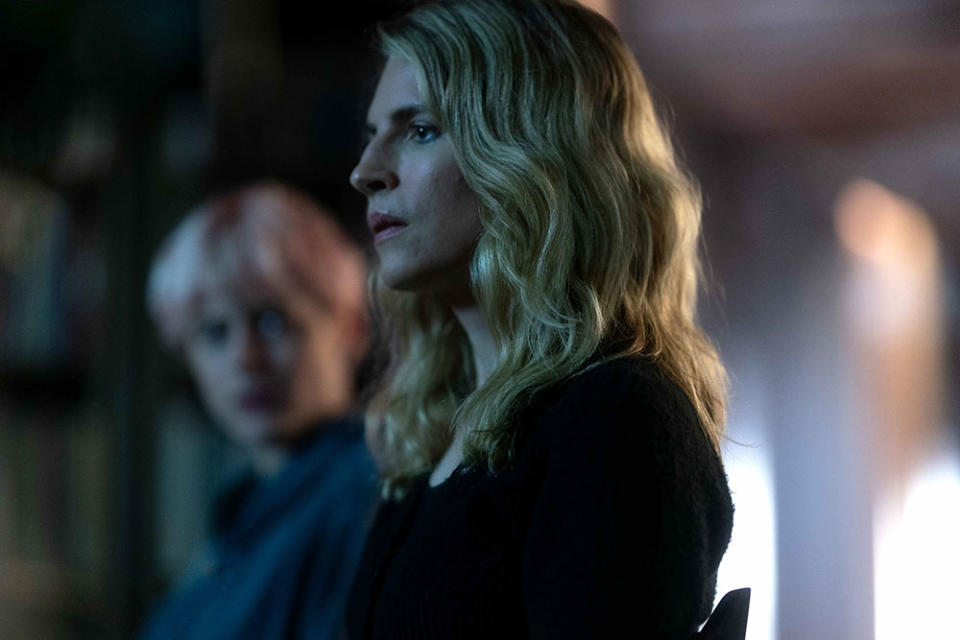
Brit, when you have the ability to generate your own material, it’s probably pretty tempting to put yourself at the center of each story, but you opted for a supporting role this time, although Lee is certainly a very important character. So, what factored into this decision?
Marling: It was a couple of things. The first big one is that I wanted to direct, and given the kinds of worlds that Zal and I tend to come up with, it’s never a couple of teenagers in Echo Park who are wrestling with coming of age. (Laughs.) It’s usually huge casts with braided worlds, big ideas and ambitious sets. And so, to be able to direct in the way I wanted to direct, it felt imperative to step back from being the lead or certainly being in every frame of it, like Darby Hart is. The other part of it was that I started thinking about activism or any kind of resistance as having to think of things in terms of intergenerational movements. In the West, we get so obsessed with the individual and what the individual can achieve, but I’m more interested in what we can achieve as collectives and what we can achieve intergenerationally. So I’ve been thinking about the feminist movement like that. I owe my ability to get into the director’s chair to Jane Campion and to Kathryn Bigelow and to so many women who managed to get there before me. When I was coming of age and we’d made those first two films at Sundance and I was being offered a lot of things out of that Sundance in 2011, there was no part like Darby Hart. There just weren’t many women writing and directing then. And so, while I was offered a lot of things by people and filmmakers and groups of people I really admired, it was often to play a part that didn’t feel right in my soul. It’d be a portrayal of a woman that just felt underdeveloped. So part of Darby Hart came from a place of wanting to write the kind of role that wasn’t an offer when I was coming of age, and to try to think about the project of telling stories that include new people in them, as a more intergenerational project.
Zal, Brit just mentioned the new wrinkle on this show, as the two of you shared directing responsibilities for the first time. Normally, you’re the tone-setter. So how would you describe this new dynamic?
Batmanglij: Not only do we share directing responsibilities in some ways, but in other ways, Brit is doing the lion’s share of it because she set the tone. And it was amazing to watch. Brit studied photography in college, and her photographs were by far the best that I’d seen from anyone I knew. So I knew that Brit was going to be a natural director; I just didn’t understand how much I would enjoy the experience of watching Brit direct. Certain actors, when they get into the directing chair, just have a sensitivity. I saw Emma and Harris [Dickinson] bloom in certain ways when Brit was working with them, and that inspired me to want to go take acting classes. (Laughs.) I want to get better at that stuff. So it was really cool to see Brit follow through on a lot of the really amazing choices that she made in the writing, like the Annie Lennox song [“No More ‘I Love You’s'”]. I remember reading her pages for the beginning and being like, “Is this the right song, Brit? She put it on headphones for me and I was like, “It’s interesting, but is it right?” And she was so right about that. I also remember being on set when Brit had chosen the El Camino. She’d been checking this El Camino out on the street from her attic window, so she gave Bill his uncle’s El Camino. And when Harris and Emma got in the car and Brit got in the back with them and asked them to start singing the Annie Lennox song, I was like, “Wow!” We weren’t shooting yet either. So to see that scene edited a year later was just a really cool experience for me.
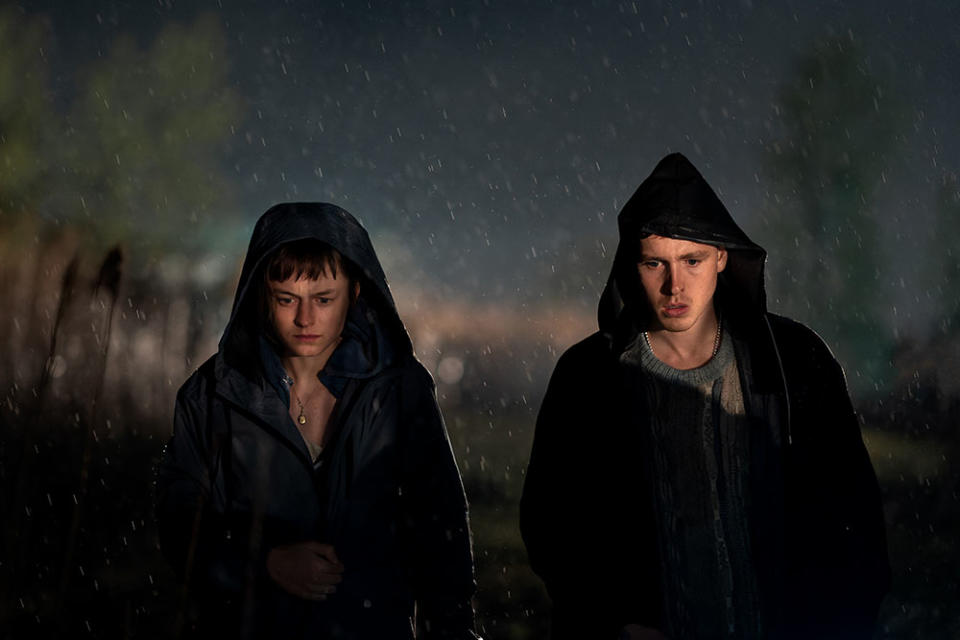
Brit, would you say your directing style is similar to Zal’s having worked together for so long? Or as an actor-director, is it more performance-driven as Zal seems to imply?
Marling: When you’ve spent a lot of years acting, you’re really aware of what actors need to create their best work. You’re just aware of how hard it is when there’s so much happening on a set in terms of moving parts. You’re aware of how hard it is for someone to come in on cue and just deliver vulnerability and honesty and openness, especially in a story like this where you’re asking a lot from actors in scenes. So, yeah, having an acting background is always helpful for a director because you understand how to protect your actors from the stresses of the set. You also understand that you have to sometimes be willing to let imperfection and flaw enter the camera apparatus because you’re trying to protect the actors’ bubble that they’re creating. So we might do a take where you’re riding in the car, and there’s a bump that shifts the camera. Everybody wants you to call cut in that moment because the frame is slightly off and you’d like to nudge it a bit to the left, but you know that your actors have hit a stride that they’re very unlikely to hit again. So you have to be willing to sacrifice that little bit of imperfection in the image because you’re capturing something more perfect in the moment, and that is the thing that the audience connects with the most. So things like that happen all the time, and understanding how difficult it is to achieve those rhythms as an actor is helpful.
Also, Zal and I are very much people that believe in being in service to the story, which is a kind of filmmaking that is inspired by a lot of people. But, for me, it’s very inspired by [Alan J.] Pakula. Whenever I watch a Pakula film, I always feel that he is, as a director, rarely inserting his own ego. He’s never auditioning for the audience or trying to prove himself or his worth as a filmmaker. He’s always giving you the image that is exactly the composition and exactly the movement that is needed to most correctly communicate that beat of the story. And as a result, when you take his work in, it’s like you can’t even perceive how it’s constructed, sometimes. It’s got a fluidity to it that is just an honesty to story. So Zal and I both respond to that kind of filmmaking, which really comes from trying to get yourself out of the way and trying to put the story as the queen and deliver what the queen needs. (Laughs.)
So maybe that’s a part of it, but we’ve also been telling stories together for years. When we were building the world of Iceland, we were like, “And then the winds from Iceland rush over the cut and they take you back into the desert. You’re in the American West. It’s red and parched, but it’s also treeless and arid. And then you follow that wind back to Iceland again.” So there are things we talk about as we’re writing that then become motifs in the filmmaking, and we both try to achieve them to create a cohesive whole.
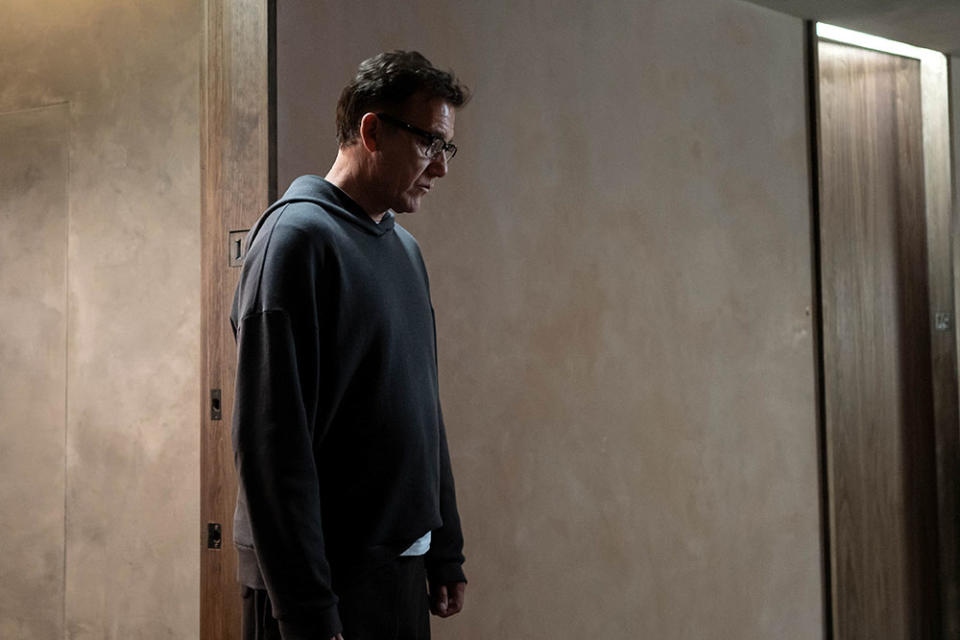
Over the last year especially, the world and our industry has had to reckon with billionaire egos and the threat of AI to people’s livelihoods, and starting with The OA’s Pierre Ruskin and now Andy Ronson (Clive Owen) and Ray the AI (Edoardo Ballerini), it seems like the two of you foresaw a lot of this to some degree. Is that fair to say?
Batmanglij: We were thinking about what Andy could do in the technology space, and we thought, “Oh, he should design AI. An AI assistant.” I use Midjourney a lot and I love it. (Laughs.) An AI assistant is a great thing, and it will change people’s lives in many ways and most ways for the better. But then we talked to our friends in the space and they were like, “No, that’s so many years away. Don’t do that. That’s a Hollywood cliché.” So that made us want to do it even more, because we felt something in our gut, but I don’t know if we foresaw it. The disparity in wealth is really sad, and the sadder part about it is that a lot of people in our era seem to really idolize the rich. They don’t feel any sort of animosity or suspicion towards the rich, and that is one of the things we were interested in showing. In the first two chapters, you don’t really see it, but as the show progresses, you see that the past is warmer and more filled with feeling in many ways. The dirty motels are nicer spaces to inhabit because they’re filled with the love that Bill and Darby share, and while the present is glistening and glamorous, it’s sterile. So the disparity in wealth wouldn’t be so bad if people were angry, but they’re not. They feel like really rich people or even moderately rich people deserve it, and I’m not sure that that’s true.
The flashbacks serve many purposes, as they not only show why Bill means so much to Darby, but they also have some insight that might prove useful in the present. What else would you add regarding the relationship between the two narratives?
Marling: In the writing and then in the filmmaking, instead of thinking of them as flashbacks, we tried to think of time in this story as a circular function rather than a linear one. We all know that the past informs the present, but we don’t sometimes think about the ways in which the present drives us to recall or remember the past, and that it rewrites the past. Every time you visit the past and remember it, you alter it, you change it, you see new things inside it. You maybe even shift points of view inside it. It may take you ten years of maturity to go back and visit an early traumatizing scene, and put yourself in someone else’s point of view in that scene and see things in it you didn’t see before. And once you do that, you are rewriting the past by reliving it, and then that is changing the present again. So we built the [Iceland] hotel as a circle in part because we wanted to think of it as the hands of time. Darby is always rushing through these corridors, trying to solve something against the clock, and she’s also pacing the hands of time, as we’re experiencing time on a kind of metaphysical level. And so, in that way, those two storylines were always essential.
But in another way, a large part of telling the past Darby’s origin story of falling in love for the first time while pursuing a cold case of a killer was about constantly earning the audience’s respect and belief that Darby could solve the crime in the present. It’s a really interesting thing because you don’t need to do that for a male detective or a detective with a badge, someone who’s authorized by gender or the legal system or profession to solve something. The moment they show up on the scene, you’re like, “Okay, this person’s got it.” But with a young woman who is the age and gender of the victim most often, a young woman who is an amateur and is authorized by nobody but herself, you have to constantly tell the audience with the other storyline that she has earned the right to be there. She can in fact go toe to toe with this tech billionaire and the other luminaries who’ve been gathered for this retreat, and she’s a formidable force.
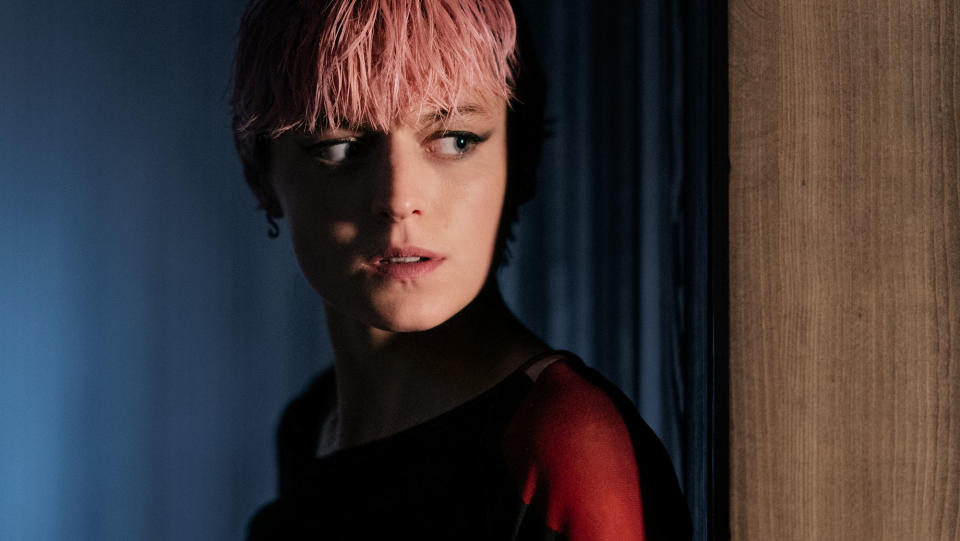
The OA united a bunch of amateur sleuths on Reddit. Was that the first domino to fall en route to creating this series’ two amateur sleuths who meet through a true-crime subreddit?
Batmanglij: Yeah, I think that’s a fair claim. As Brit said, the unexpected ending of The OA was also a gift because we saw people collectively come together. And that made us realize, “Oh, there’s a lot of beauty to the internet uniting disparate people.” So the power of collective action has long mattered to us, and it’s really hard to do within the framework of hero storytelling. So, with The OA, it was cool that it was the result of the story. Maybe the ending of the show is kind of the fact that all those people got united anyway, and so I think that awakened in us this sense of hope that the internet can unite people.
This is probably wishful thinking, but were you able to schedule the flashbacks first so that Emma and Harris could use them to inform their present-day performances?
Marling: That would’ve been a dream scenario. We talked about that, but because of the weather constraints, we were always up against losing the snow in Iceland. So, at some point we reached a place where we had to get on that plane and go, or there wasn’t going to be any snow left. In fact, at the very end of shooting, there was no snow left, so we were sending dump trucks further north to gather snow and dump it in front of the set. But I actually think that this speaks to the circular nature of time I was talking about earlier. On a normal project, you really would’ve wanted to shoot the past first, but it’s actually critical that we shot the past last. It was about saying that time is a circle and that everything they experienced in the present moment in Iceland is actually a part of how we are remembering the past and what we are choosing to remember from the past, what we need to remember and why. So it actually really worked for us.
Also, just in terms of production, by the time we were in Utah, we’d reached a place in the pandemic where we could shoot outside without masks, and that just completely changed the shooting experience. We were also able to get back to our roots as filmmakers, which is to just let some of the huge apparatus fall away and be 25 people and a truck in these spaces, shooting in an actual side-of-the-road motel, not a set. And getting small and nimble like that, and being just with Emma and Harris and having that intimacy of a small cast at that point, it really created a kind of forcefield that let us achieve some of the feelings of those scenes, because we had just gotten to the nadir of the story.
Batmanglij: One of my favorite moments directing or witnessing the story unfold was at the diner when [Bill and Darby] meet each other for the first time in real life. It’s the end of chapter two, and we were in the middle of Green River, Utah, in this small diner. And the wait staff and the bartenders from the diner were playing those parts on the show. And I remember we were blasting Frank Ocean’s “Moon River,” as [Bill and Darby] were seeing each other. [Writer’s Note: “Moon River” is also the needle drop in the actual scene.] And Brit has long talked about how when you first see the person that you love and you feel that intense love when you look in someone’s eyes, you’re also understanding that you’re going to lose them. You’re seeing the moment of their death or the moment of the dissolution of your relationship. So it’s happening instantaneously, and Emma and Harris really captured that in that moment. And if we’d done it first, I don’t think you could have brought all the pain of the future into that moment. Love really does contain all of those multitudes in just an instant of looking at someone.
I have to let the two of you go, but I just want to say that I still remember the bright-colored domes of Saint Basil’s Cathedral.
Marling: (Marling smiles, recognizing her character’s words that introduce The OA’s rule-breaking title sequence.) Thank you for this beautiful conversation.
Batmanglij: We hope to talk to you when we make The OA 3.
Marling: (Laughs.)
Please don’t tease me, Zal.
Batmanglij: I’m not! One day …
I still listen to Prairie’s violin theme all the time.
Marling: I listen to it, too! [Composer] Rostam [Batmanglij] really hit on something with that melody, but it’s true what Zal is saying. Twin Peaks came back after a long time. We just need the conditions and the circumstances to be right. Dormant seeds in the desert do bloom, so who knows?
***
A Murder at the End of the World is now streaming on FX on Hulu.
Best of The Hollywood Reporter

